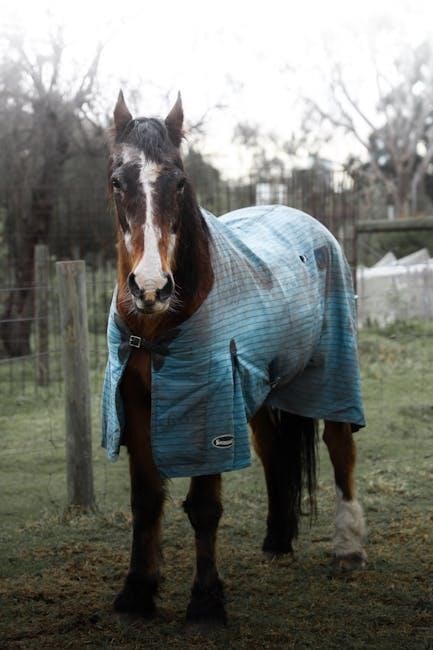
Blanketing helps regulate a horse’s body temperature, ensuring comfort in varying climates. Factors like age, coat type, and weather influence when to blanket, typically starting below 50°F.
Understanding the Importance of Blanketing
Blanketing is essential for protecting horses from harsh weather and maintaining their comfort. It helps regulate body temperature, prevents shivering, and reduces energy loss. Proper blanketing supports thermoregulation, especially for clipped, young, or elderly horses, ensuring they stay warm and healthy during cold conditions.
Factors Influencing Blanketing Needs
Horse age, health, coat type, and living conditions significantly influence blanketing needs. Young, elderly, or sick horses often require extra warmth. Clipped or thin-coated horses need more protection, while thick-coated horses may need less. Weather conditions, such as wind or rain, also play a role in determining the appropriate blanket weight and type.

General Temperature Guidelines for Blanketing
Blanket based on temperature: above 50°F, no blanket needed; 40-50°F, lightweight for clipped or vulnerable horses; 30-40°F, medium weight; below 30°F, heavyweight or layering.
Above 50°F (10°C): No Blanket Needed
At temperatures above 50°F (10°C), most horses are comfortable without a blanket. Their natural coat provides adequate insulation, and additional covering could cause overheating, especially in unclipped horses. However, clipped or thin-skinned horses might need a lightweight sheet for protection, even at these milder temperatures, to prevent chilling in windy or damp conditions. Always monitor your horse’s comfort and adjust accordingly.
40°F ⏤ 50°F (4°C ⏤ 10°C): Lightweight Blanket for Clipped or Vulnerable Horses
At temperatures between 40°F and 50°F (4°C ー 10°C), clipped or vulnerable horses benefit from a lightweight blanket. Clipped horses lose natural insulation, making them prone to chilling. Elderly, young, or thin-skinned horses may also need protection. A lightweight blanket provides warmth without causing overheating, ensuring comfort during cooler spring or fall days. Monitor your horse’s condition to avoid overblanketing.
30°F ⏤ 40°F (-1°C ー 4°C): Medium Weight Blanket
30°F ⏤ 4°C ⏤ 4°C): Medium Weight Blanket
When temperatures drop to 30°F ー 40°F (-1°C ⏤ 4°C), a medium weight blanket is ideal. This range signals cooler weather where horses may need extra warmth, especially if clipped or lacking a thick coat. The medium weight provides insulation without overheating, ensuring comfort and energy conservation during colder periods. Consider wind and moisture for added protection.
Below 30°F (-1°C): Heavyweight Blanket or Layering
For temperatures below 30°F (-1°C), a heavyweight blanket is essential to protect your horse from extreme cold. Layering with a medium weight blanket under a heavyweight one can provide additional warmth. This is crucial for maintaining body heat and preventing hypothermia, especially for horses without a thick winter coat or those exposed to harsh winds and moisture.
Factors to Consider When Deciding to Blanket
Factors include horse age and health, coat type and clipping, and weather conditions. These elements help determine the appropriate blanket weight and type for your horse’s comfort and needs.
Horse Age and Health Status
Young, elderly, or health-challenged horses often need extra protection. Their ability to regulate body temperature may be weaker, requiring blanketing at higher temperatures. Lightweight or medium-weight blankets are ideal for these cases to prevent discomfort and heat loss, ensuring their overall well-being during colder months.
Coat Type and Clipping
Horses with full winter coats may need less blanketing, starting around 30°F, while clipped horses require protection earlier, often at 40°F. The thickness and condition of the coat, along with any clipping, determine the appropriate blanket weight and when to start using it for comfort and warmth.
Weather Conditions (Wind, Rain, Snow)
Weather conditions significantly impact blanketing decisions. Wind and rain can chill horses faster, necessitating a blanket even at higher temperatures. Snow and freezing conditions may require heavier blankets or layering. Always monitor your horse’s comfort, especially in harsh weather, and adjust their blanket accordingly to prevent discomfort or health issues.
Indoor vs. Outdoor Living Conditions
Horses in indoor environments may require lighter blankets due to controlled temperatures. Outdoor horses need heavier, waterproof blankets to protect against wind, rain, and snow. Adjust blanket weight and type based on living conditions to ensure your horse stays warm and comfortable year-round.

Types of Horse Blankets
Horse blankets vary by weight, material, and purpose. Lightweight for mild temps, medium for chill, and heavyweight for extreme cold. Waterproof options protect from rain and snow.
Lightweight Blankets
Lightweight blankets are ideal for milder temperatures, typically between 40°F to 50°F (4°C to 10°C), especially for clipped or sensitive horses. They provide minimal warmth without causing overheating, making them perfect for spring or fall when the weather is cool but not freezing. These blankets are often used as a preventive measure to avoid chilling.
Medium Weight Blankets
Medium weight blankets are suitable for temperatures between 30°F and 40°F (-1°C to 4°C). They provide adequate warmth for average winter conditions, particularly for horses with a natural winter coat or those in moderate climates. These blankets are designed to offer insulation without being too heavy, ensuring comfort and preventing overheating during cooler weather.
Heavyweight Blankets
Heavyweight blankets are essential for extreme cold, typically used when temperatures drop below 30°F (-1°C). They provide maximum insulation and are ideal for horses without a thick winter coat or those exposed to harsh, windy, or snowy conditions. Layering with a lightweight blanket can enhance warmth for added protection in freezing temperatures.
Waterproof and Breathable Options
Waterproof and breathable blankets are crucial for protecting horses in wet or snowy conditions. These blankets prevent moisture from penetrating while allowing sweat to escape, reducing the risk of chilling. They are recommended for temperatures between 30°F and 50°F (-1°C to 10°C), especially for horses exposed to rain or humidity, ensuring they stay dry and warm.
How to Choose the Right Blanket
Selecting the right blanket involves measuring your horse, considering weather conditions, and matching weight to temperature. Lightweight for 40-50°F, medium for 30-40°F, and heavyweight below 30°F ensures optimal comfort and protection against cold, wind, and moisture, while preventing overheating and discomfort during warmer winter days.
Measuring for Proper Fit
Measure your horse from the center of the chest to the tail to determine the correct blanket size. Ensure a snug, even fit to prevent chafing or restriction. Proper fit ensures optimal warmth and comfort, avoiding unnecessary stress or discomfort during cold weather conditions.
Selecting the Right Weight and Material
Choose lightweight blankets for temperatures above 40°F, medium weight for 30–40°F, and heavyweight for below 30°F. Opt for breathable, waterproof materials to prevent moisture buildup and ensure warmth. Consider synthetic or wool options based on durability and your horse’s specific needs for optimal comfort and protection during colder months.
Considering Durability and Maintenance
Choose high-quality, durable materials to withstand harsh weather. Regular cleaning and inspections ensure longevity, while proper storage prevents damage. A well-maintained blanket provides consistent warmth and protection, essential for your horse’s comfort during colder months. Daily adjustments and seasonal checks help maintain its condition and effectiveness over time.

Signs Your Horse Needs a Blanket
Visible shivering, loss of appetite, or behavioral changes indicate your horse needs a blanket. Monitor these signs, especially in temperatures below 45°F (7°C), to ensure comfort.
Visible Shivering
Shivering is a clear sign your horse is cold, especially in temperatures below 40°F (4°C). If your horse shivers persistently, consider a heavier blanket to prevent heat loss and discomfort. Monitoring for prolonged shivering helps ensure your horse stays warm and maintains energy reserves during colder months, promoting overall health and well-being.
Loss of Appetite
A horse’s reduced appetite can signal discomfort due to cold stress. When temperatures drop below 40°F (4°C), horses may eat less as they expend more energy to stay warm. Monitor eating habits closely, as a noticeable decrease in appetite could indicate the need for a heavier blanket to help your horse conserve energy and stay comfortable.
Changes in Behavior
Changes in your horse’s behavior, such as restlessness, lethargy, or unwillingness to move, can indicate cold stress. Monitor these signs closely, as they may suggest your horse is uncomfortable and needs additional warmth. Adjusting the blanket or adding layers can help restore your horse’s natural behavior and comfort level during colder temperatures.
Maintaining Your Horse’s Blanket
Regular cleaning and inspections ensure your horse’s blanket remains effective. Proper fit and storage prevent damage, while seasonal rotation keeps your horse comfortable year-round.
Regular Cleaning and Inspection
Regularly clean and inspect horse blankets to remove dirt and mold, ensuring optimal comfort. Check for tears and worn areas to maintain durability. Store blankets in a dry, clean space during off-seasons to preserve quality and prevent damage, ensuring they remain effective for future use. Proper maintenance extends the blanket’s lifespan.
Ensuring Proper Fit and Adjustments
Ensure the blanket fits snugly, allowing free movement without rubbing. Check neck openings, shoulder room, and girth straps regularly. A well-fitting blanket prevents chafing and discomfort. Adjust straps as needed to accommodate your horse’s build and seasonal changes in condition. Proper fit ensures warmth, comfort, and prevents overheating, while allowing natural movement and grazing ability.
Storage and Seasonal Rotation
Store horse blankets in a clean, dry, and well-ventilated area to prevent mold and pests. Clean and dry blankets thoroughly before storage. Rotate blankets seasonally, switching between lightweight, medium, and heavyweight options based on temperature changes. Proper storage and rotation ensure blankets remain in good condition and provide optimal warmth when needed.

Regional Temperature Variations
Blanketing strategies vary by region due to climate differences. Mild climates may require lighter blankets, while harsh winters demand heavier ones, ensuring horses stay comfortable in diverse conditions.
Blanketing in Mild Winter Climates
In mild winter climates, horses typically require lighter blankets or sheets, especially if temperatures remain above 40°F. Unclipped horses with thick coats may not need blanketing, while clipped or vulnerable horses benefit from lightweight options to prevent chilling. Always consider wind and rain exposure when deciding to blanket in these regions.
Blanketing in Harsh Winter Climates
In harsh winter climates, horses often require heavyweight blankets or layering when temperatures drop below 30°F. Unclipped horses may still need protection from extreme cold, wind, and moisture. Vulnerable horses, such as the young, old, or thin, may benefit from additional layers. Proper fit is crucial to prevent chilling and ensure comfort in extreme conditions.
Adjusting for Unpredictable Weather Patterns
Monitor weather forecasts to adjust blanketing according to sudden temperature drops, wind, or rain. Use waterproof and breathable blankets to protect against moisture. Layering options provide flexibility for fluctuating conditions. Always ensure proper fit and check your horse’s comfort daily, as unpredictable weather can quickly change their needs.
Proper blanketing ensures your horse stays comfortable. Monitor their comfort, adjust based on conditions, and follow the temperature guide for optimal care.
Final Tips for Effective Blanketing
Monitor your horse’s comfort closely, adjusting blankets as needed. Ensure proper fit and check daily for signs of discomfort or restriction. Consider layering in extreme cold and always prioritize your horse’s health and behavior cues for optimal care.
Monitoring Your Horse’s Comfort
Always observe your horse’s behavior and physical signs. Look for shivering, sweating, or unusual posture. Ensure the blanket fits properly and adjust based on temperature changes. Regularly check for signs of overheating or chilling, and remove or replace blankets as needed to maintain your horse’s optimal comfort and well-being.